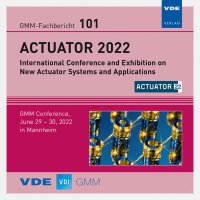A New Simple Method for Detecting Biofilms Using Heatable Capacitive Sensor Structures (CSS)
Konferenz: ACTUATOR 2022 - International Conference and Exhibition on New Actuator Systems and Applications
29.06.2022 - 30.06.2022 in Mannheim
Tagungsband: GMM-Fb. 101: ACTUATOR 2022
Seiten: 4Sprache: EnglischTyp: PDF
Autoren:
Zirk, Kai-Uwe; Kemper, Markus; Kolhoff, Christoph; Dummeier, Patrick; Olze, Manuel; Poetzschke, Harald (PHWT - Private Hochschule für Wirtschaft und Technik, Fachbereich Mechatronik und Elektrotechnik, Diepholz, Germany)
Inhalt:
Biofilms are slimy excretions of bacteria that form a habitable microenvironment in which these bacteria are well protected. In the majority of relevant cases in the human environment biofilms are undesirable, either only disturbing, or even being a considerable hazard for human beings. A new, very simple and robust method for the detection of superficial biofilms with surface-integrated heatable capacitive sensor structures (CSS) was developed, with which both heating and capacitive measurements can be carried out. First, most of the ‘free’ water (water not bound to a biofilm matrix) must be allowed to drain off. Thereafter (1) residual ‘free’ water is completely evaporated by a standardized (sufficient) heating in order to (2) finally capacitively determine the residual amount of water bound to a potentially existing biofilm matrix. Water (either free, or bound within the matrix of a biofilm) has a relative permittivity about 80 times greater than air and can therefore change the electrical capacitance of a sensor structure as an additional dielectric (in addition to the fundamental electrical capacitance of the dry sensor structure): With a (residual moisture) biofilm on the surface, a sensor structure exhibits a greater capacitance compared with its completely dry (= biofilm-free, dried by heating) state; an increase in capacitance is evident. If this increase in capacitance exceeds a threshold (which has to be well justified experimentally ex ante), the existence of a biofilm is proven. For a proof of concept and the following technical development (1) suitable planar electrically conductive sensor structures especially a variety of conductor strengths - were designed and their electrical features (PC-based) modulated. (2) Flexible capacitive sensor structures (printed circuit boards) made from polyimide (double spirals, interdigitating double combs, and double meander structures) with two electrically insulated conductors made of copper that form a planar capacitor with a spatial electric field were produced. Subsequently their real electrical characteristics were determined and compared. In principle, the capacitive sensor structures (except for the double combs) also enable a defined heating process (in alternation) by applying current. To ensure reproducible conditions a medical hydrogel was chosen as a technical biofilm model, which imitates many characteristics of a real biofilm and can be sprayed onto the sensor structures in thin layers (a few micro meters) similar to water. From all investigated sensor structures a special single-layer double meander (M2) proved to be very advantageous as they form an optimal combination of both capacitive measurement and heating possibility while being manufactured in a single layer. Furthermore, a higher thickness of the copper circuit track results in a high basal capacitance. A proof of concept was achieved with a structure of interdigitated combs (heated by an additional heating foil on its reverse side). The time profiles of the electrical capacity without and after being sprayed with 1 mL of water or 1 mL of hydrogel largely correspond to the theoretically derived profiles. The further development of heatable (double meander) sensor structures will be achieved with rigid ceramic PCBs, which in contrast to polyimide PCBs do not absorb water and can be heated at the same time by current flowing through the conductor.


